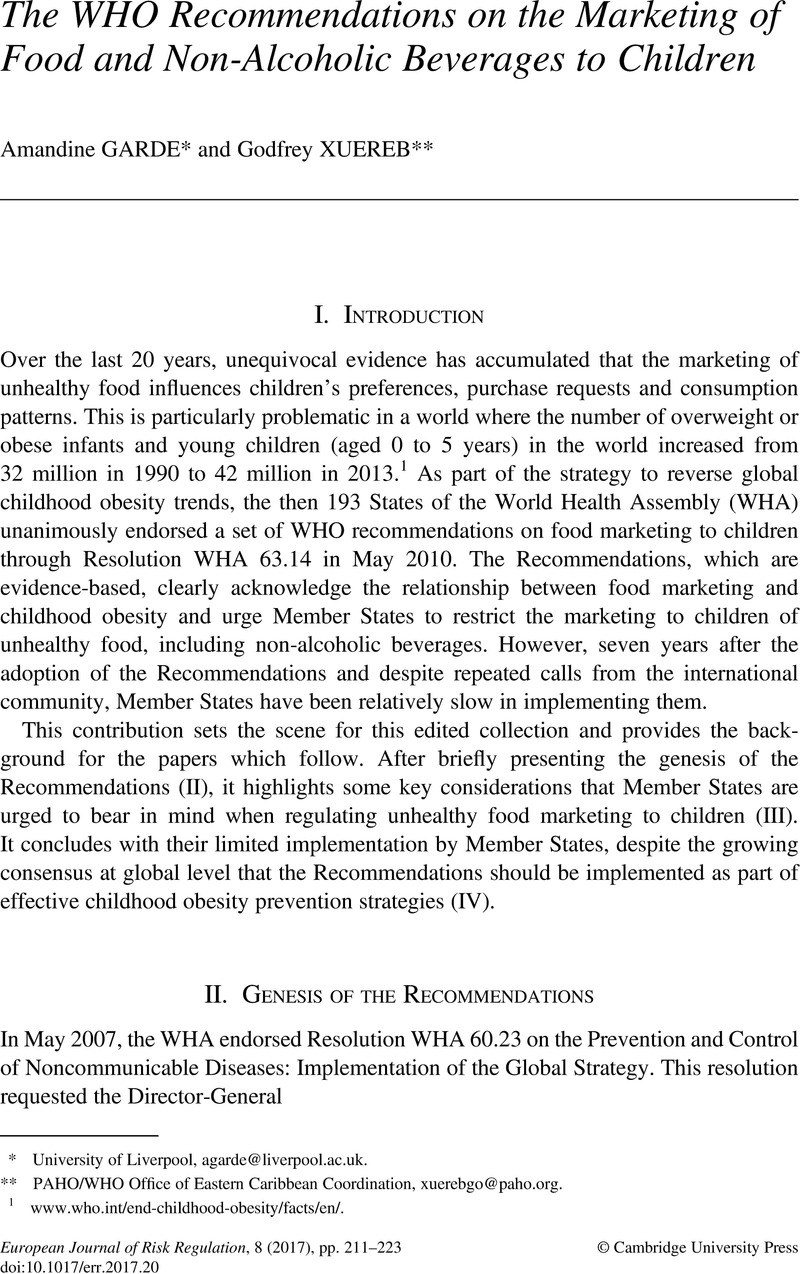Published online by Cambridge University Press: 21 July 2017

University of Liverpool, [email protected].
PAHO/WHO Office of Eastern Caribbean Coordination, [email protected].
3 Similarly, Resolution WHA57.17 requested the Director-General “to cooperate with civil society and with public and private stakeholders committed to reducing the risks of non-communicable diseases in implementing the Strategy and promoting healthy diet and physical activity, while ensuring avoidance of potential conflicts of interest”.
4 The NGO report is available at www.who.int/dietphysicalactivity/dialogue_non_governmental_organizations_20nov2008.pdf?ua=1; and for the private sector report, see www.who.int/dietphysicalactivity/dialogue_private_sector_24nov2008.pdf?ua=1.
5 Both the Recommendations and the Framework Implementation Report are available at www.who.int/dietphysicalactivity/marketing-food-to-children/en/index.html.
6 The Recommendations specifically refer to the following studies: Hastings, G et al., Review of the Research on the Effects of Food Promotion to Children (Glasgow, University of Strathclyde, 2003)Google Scholar; Hastings, G et al., The Extent, Nature and Effects of Food Promotion to Children: a Review of the Evidence (Geneva, World Health Organization, 2006)Google Scholar; McGinnis, JM, Gootman, JA, Kraak, VI (eds), Food Marketing to Children and Youth: Threat or Opportunity? (Washington DC, Institute of Medicine, National Academies Press, 2006)Google Scholar; and
Cairns, G, Angus, K, Hastings, G, The Extent, Nature and Effects of Food Promotion to Children: a Review of the Evidence to December 2008 (Geneva, World Health Organization, 2009)Google Scholar.
7 Note 2, at p. 7.
8 The etymological origin of “advertising” derives from the Latin ad-vertere and means “to turn towards”. Even though a marketing campaign may not achieve its objectives, it will have attempted to do so and will therefore fall within the scope of the WHO Recommendations: emphasis is placed not only on the effect but also on the intention of the business actor in question: see Framework Implementation Report (WHO, 2012).
9 For example, EU Directive 2010/13 on audiovisual media services (AVMS) explicitly distinguishes television advertising from other forms of commercial communications, such as sponsorship and product placement.
10 States may require a nutrition declaration on pre-packaged food.
11 This issue had been raised by many Member States during the consultation that led to the Recommendations. The special situation of schools as a setting where children are a captive audience and the health-promoting role that schools should have were identified as requiring specific attention in the Recommendations.
12 At p. 22.
13 Recommendation 6.
14 Recommendation 8. Fifteen Member States raised cross-border marketing as an issue of particular concern.
15 Art. 26 of the Treaty of the Functioning of the European Union (TFEU) defines the internal market as “an area without internal frontiers in which the free movement of goods, persons, services and capital is ensured in accordance with the provisions of the Treaties”.
16 For more information on the various stages of the policy process, see the Framework Implementation Report accompanying the Recommendations (WHO, 2012).
17 At para. 43.
18 The economic consequences of NCDs are staggering. If intervention efforts remain static and rates of NCDs continue to increase as populations grow and age, cumulative economic losses to low-and-middle income countries from the four diseases are estimated to surpass USD 7 trillion over the period 2011–25 (an average of nearly USD 500 billion per year). This yearly loss is equivalent to approximately 4% of these countries’ current annual output: see WHO, From Burden to “Best Buys”: Reducing the Economic Impact of Non-communicable Diseases in Low- and Middle-income Countries, The Global Economic Burden of NCDs and Scaling up action against noncommunicable diseases: How much will it cost? (Geneva, 2011).
19 Resolution WHA 66.10.
20 At paras. 4, 37, 38, 39 and 45, as well as in the Annex.
23 Consideration of the evidence on childhood obesity for the Commission on Ending Childhood Obesity: Report of the Ad hoc Working Group on Science and Evidence for Ending Childhood Obesity (WHO, 2016) pp. 69–79 in particular: apps.who.int/iris/bitstream/10665/206549/1/9789241565332_eng.pdf?ua=1.
25 Report of the ECHO Commission, at p. 18.
27 UN General Assembly, Resolution 70.259, United Nations Decade of Action on Nutrition (2016–2025), A/RES/70/259 (15 April 2016).
28 UN General Assembly, Resolution 70/1, “Transforming our World: The 2030 Agenda for Sustainable Development”, A/RES/70/1 (25 September 2015). See www.un.org/sustainabledevelopment/sustainable-development-goals/.
29 UN General Assembly, Resolution 70.259, United Nations Decade of Action on Nutrition (2016– 2025), A/RES/70/259 (15 April 2016).
30 www.euro.who.int/__data/assets/pdf_file/0003/147729/wd12E_NCDs_111360_revision.pdf?ua=1. The Action Plan was adopted in Baku in September 2011 by Resolution EUR/RC61/R3.
31 www.euro.who.int/__data/assets/pdf_file/0003/234381/Vienna-Declaration-on-Nutrition-and-Noncommunicable-Diseases-in-the-Context-of-Health-2020-Eng.pdf?ua=1. See in particular para. 12, where Member States have committed to the creation of healthy food and drink environments “by taking decisive action to reduce food marketing pressure to children with regard to foods high in energy, saturated fats, trans fatty acids, free sugars or salt” (among other measures).
32 European Food and Nutrition Action Plan for 2015-2020 (WHO EURO, 2014): www.euro.who.int/__data/assets/pdf_file/0008/253727/64wd14e_FoodNutAP_140426.pdf?ua=1. See in particular paras. 29–30 and 46–50.
33 EUR/RC66/11.
34 This model divides food into distinct categories and identifies those which cannot be marketed to children: www.euro.who.int/en/health-topics/disease-prevention/nutrition/publications/2015/who-regional-office-for-europe-nutrient-profile-model. Nutrient profiling is the science of classifying or ranking food according to its nutritional composition for reasons related to preventing disease and promoting health. Nutrient profiling can be used for various applications, including marketing of foods to children and implementing the WHO Recommendations (www.who.int/nutrition/topics/profiling/en/). The Framework Implementation Report accompanying the WHO Recommendations lists a range of models at pp. 26–28.
37 The training report was published in March 2017 and is available at www.euro.who.int/en/health-topics/disease-prevention/tobacco/publications/2017/key-considerations-for-the-use-of-law-to-prevent-noncommunicable-diseases-in-the-who-european-region-2017.
38 WHO Europe, Marketing of foods high in fat, salt and sugar to children: Update 2012–2013 (Copenhagen, 2013), which also provides an updated review of existing literature on the relationship between food marketing and food preferences which IASO (now World Obesity Federation) compiled as part of the Stanmark Project (www.worldobesity.org/site_media/uploads/Marketing_children_literature_Jul13.pdf, September 2012). Further references can also be found in M Friant-Perrot and A Garde, L’impact du marketing sur les préférences alimentaires des enfants (Institut national de prévention et d’éducation pour la santé, 2015).
39 Tackling food marketing to children in a digital world: trans-disciplinary perspectives. Children’s rights, evidence of impact, methodological challenges, regulatory options and policy implications for the WHO European Region (WHO Regional Office for Europe, 2016).